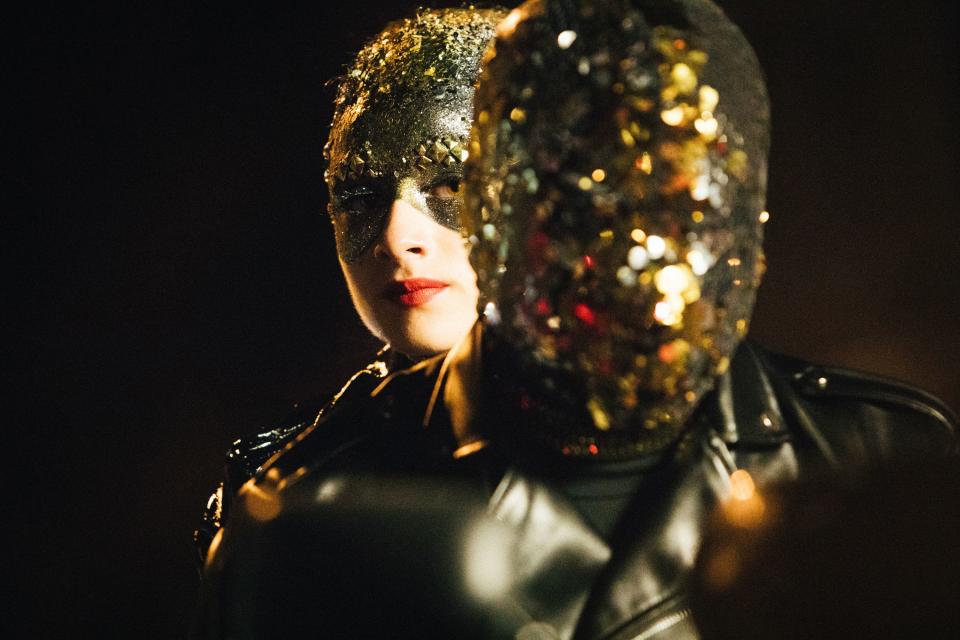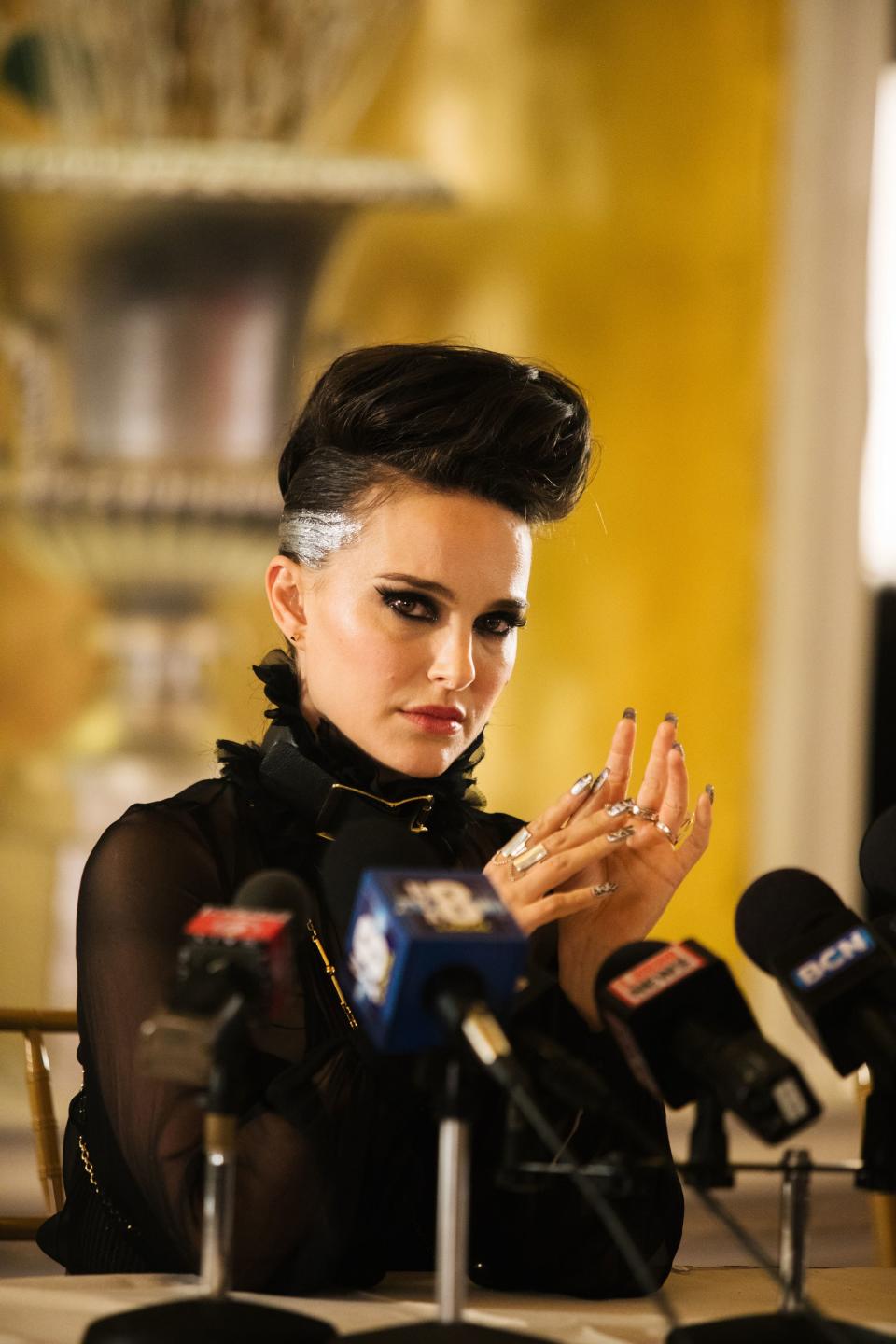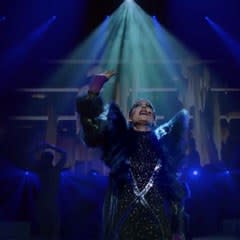Natalie Portman's Pop Star Turn in Vox Lux Bristles with Apocalyptic Foreboding...and Glitter
In Vox Lux, Brady Corbet's bleakly glittery film about a pop singer's ascent to stardom, all is not well in the firmament. What becomes of fame when it's borne out of infamy? How corrosive is the spotlight? By the second half of the movie, when we meet a mid-career Celeste (played with visceral bravado by Natalie Portman), she's on the brink of her 2017 comeback album. Her family life is in tatters, her public image dragged through the tabloid ringer. Nodding off in the makeup chair before getting roused to address the press, she goes off-script when a reporter asks about a recent mass shooting. “I was hesitant to even make a statement today because all these ultra-violent thugs want is to make headlines,” Celeste says, her black kohl-rimmed gaze lit up by a flash of silver eye shadow. “If everyone stopped paying attention to them, they would cease to exist. So would people like me, I guess.”
That uncomfortable juxtaposition—violence and performance for the sake of who's watching—lies at the heart of film. (If the last century was marked by "banality of evil," Corbet has said in interviews about Vox Lux, this century will be about the "pageantry of evil.") It also finds an unlikely manifestation in the onscreen makeup: a series of metallic pigments, glued-on rhinestones, and sparkly face-obscuring hoods.
Glitter, after all, begs the limelight. The first example comes early, in the brutal opening scene. It's the year 2000, and a coltish teenage Celeste (Raffey Cassidy) is in band class when a now-familiar tragedy strikes. When we finally catch sight of the armed student, his eyes are blacked out by custom-fitted contact lenses, with a platinum smear across his lids. It's an effect intended to "make someone look empty inside," says the film's makeup department head Anouck Sullivan, who credits Corbet with the idea. (Later on, the visual rhyme with the pop star's press-conference makeup isn't lost on close observers.)
Celeste is one of the lucky ones—struck in the neck by a bullet, rescued from the brink—and an original song performed at the memorial turns her into a precocious national treasure. Success comes in a sparkling blur. The ingenue's debut music video reads like a metaphor for warp-speed adolescence in the public eye: Riding on a motorcycle behind a driver in a spangled balaclava, she gazes at the camera through a painted-on mask of chunky, silver glitter. “She hides behind this pop-star persona and all of this makeup,” says Sullivan, describing a default mode for Celeste that carries through to her 30s. (By contrast, her self-effacing sister, played by Stacy Martin, keeps it bare-faced.) "Then she gets onstage and she shines."

Heavy stuff, but on the five-week set of Vox Lux, there was a lighter kind of sparkling blur. "It was like a glitter bomb had gone off in the trailer!" Sullivan recalls with a laugh, describing an all-hands-on-deck pace to keep Cassidy and her stunt doubles in disco-ball form. For inspiration, she pulled images of David Bowie and other glam-rock icons; she also looked back on her own '90s-era dip into the San Francisco rave scene. "I used to be kind of a club kid, and I would always douse myself in glitter and use lashes and rhinestones," says Sullivan. She later built upon that experience with fashion-week stints on teams lead by backstage legends Dick Page and Tom Pecheux.
In Vox Lux, those makeup tricks are sometimes deployed in subtle ways, like the drawn-on facial moles that young Celeste wears to match Portman's real-life beauty marks. But it's the decadent looks that bring a fully-realized pop star to life. In the concert-doc-style finale (an homage to the late director Jonathan Demme, to whom the film is dedicated), a lithe Portman zigzags across the stage in a shimmering turtleneck bodysuit and silver-painted hair. On a jumbo-size screen, the words PAST PRESENT FUTURE conflate time in the same way that her makeup does: '80s-leaning fuchsia blush set against alien-esque crystals in a brow-skimming V.
The songwriting is credited to Sia, but the performance belongs entirely to Portman. "She really put so much into her character," Sullivan says, from the vocals to the choreography (by Benjamin Millepied, the actress's husband) to the tattoo that Portman wanted Celeste to have. They decided on a snake: "It felt powerful and of the time, as if she'd gotten it in the early 2000s," says Sullivan. The silver holographic talons were also Portman's idea—something the costume designer Keri Langerman loved so much, she cut the tips off the gloves for the pop star's stage look. Of course, freed-up fingertips have another benefit in a digital world where we're all stars of our own making. As the camera pulls back, revealing the fans in Celeste's audience, a thousand outstretched phones twinkle in the darkness.



